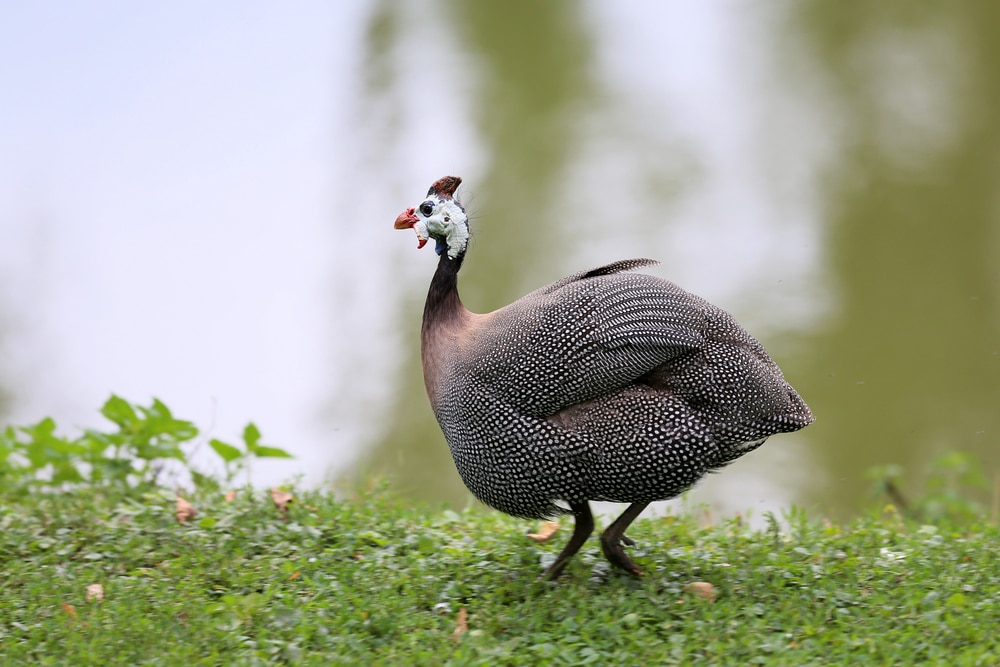Once considered a more exotic species of backyard birds, the guinea fowl is rapidly growing in popularity.
This bird is one of many names, including “Pet Speckled Hen” and “Guinea Hen,” but guinea fowl is without a doubt the most popular.
A peculiar looking bird, it’s sure to be the talk of the town no matter where you might live. It also has unique behavioral characteristics that are sure to endear – or potentially even aggravate! – you from time to time.
Raising guinea fowl isn’t for everyone, and certainly not without its challenges.
However, like any kind of backyard poultry, guinea fowl present a ton of benefits to commercial and pet poultry farmers alike.
Here’s everything you need to know about raising guinea fowl.
Guinea Fowl History
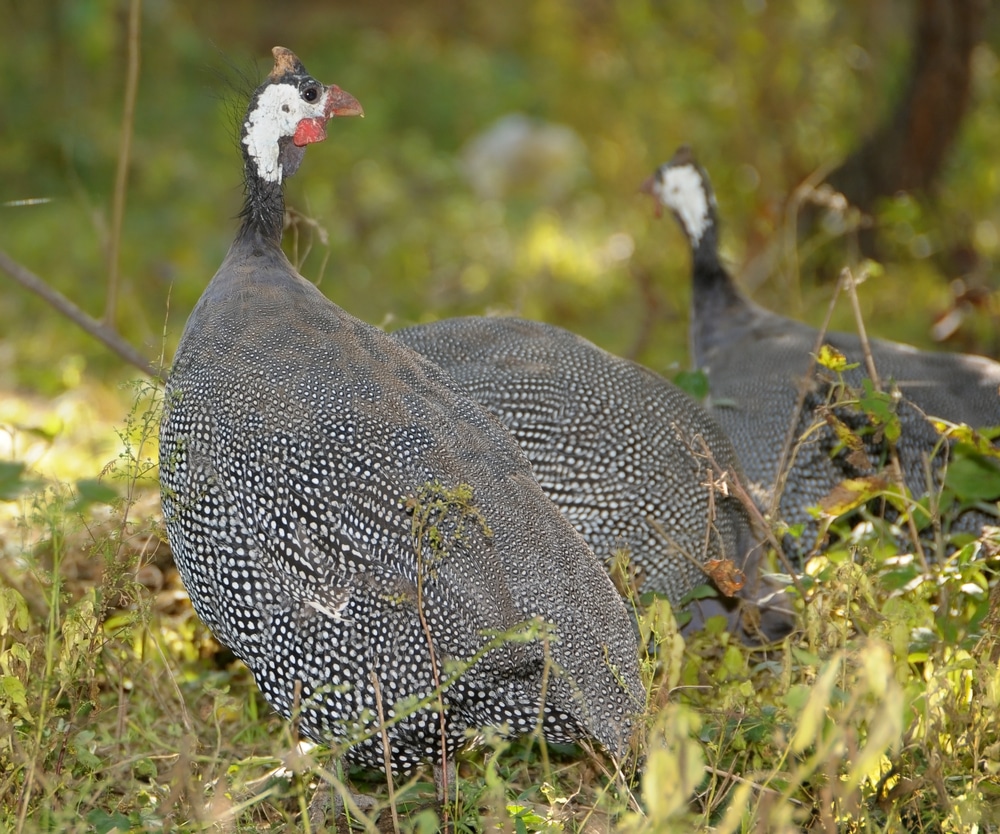
As members of the Numida family, guinea fowl are more closely related to birds like pheasants, turkeys, and other game fowl species than they are to chickens.
Some people believe that guinea fowl were raised as far back as ancient Greek times!
Believed to have originated around 500 BC, these creatures were brought back to the Romans from the native region of Africa.
After many semi-successful and semi-failed attempts at raising guinea fowl, it became clear that you can raise guinea fowl with moderate success – but you won’t be able to tame them.
This is because guinea fowl are inherently wild birds. Native to Africa, the birds are rampant here, running wild in large flocks.
They are also considered part of the natural landscape of modern Jamaica since they were brought here in the 1800s during the peak slave trading days.
Brought to Europe in the 1400s, the guinea fowl eventually made its way to America on the ships of some of the earliest settlers.
Appearance
There are countless types of guinea fowl, but usually, those that you see running around barnyards are helmeted guinea fowl.
The most common domesticated type of guinea fowl, his bird has a knob on its head that gives it a helmet-like appearance.
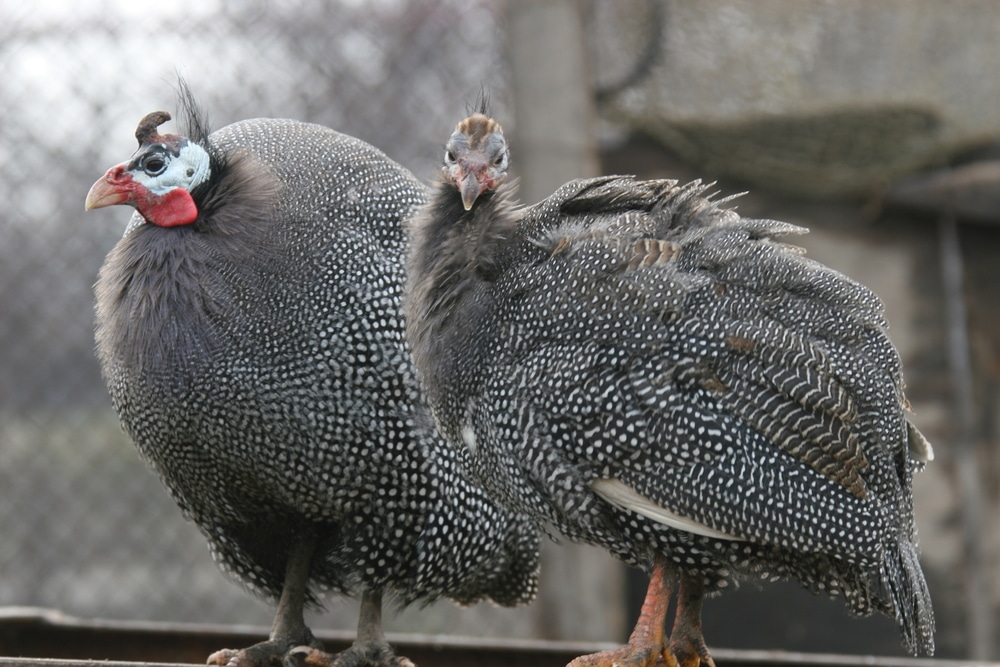
Another common type of guinea fowl is the Crested Guinea Fowl. These birds are typically regarded as the most aggressive type of guinea.
They will chase people down indiscriminately -attacking even their owners. These birds are identifiable by curly mops on the tops of their heads.
Other less-common varieties of guinea fowl include the White-Breasted, Black, Vulturine, and Plumed Guinea Fowl.
Difference Between Different Types of Guineas
To break down the differences:
- White Breasted: This bird is found mostly in West Africa. It is listed with a status of “vulnerable” according to the International Union for Conservation of Nature due to extensive habitat loss.
- Black: This type of guinea fowl can only be found in central Africa.
- Vulturine: The largest of the guinea fowls, this bird has a striking appearance and is one of the tamest species. It needs to be raised in large groups in order to be healthy.
- Plumed: This is a rare species of guinea fowl, which can only be found in central Africa. Very little is known about it.
Despite the fact that guinea fowl come in all kinds of varieties, shapes, sizes, and colors, there are some traits that they tend to share.
Common Guinea Colors
For instance, these birds can be found in a variety of colors. Popular shades and patterns include:
- Pearl
- Royal Purple
- Buff
- Bronze
- Chocolate
- Coral Blue
- White
Not all of these colors are recognized by official standards, with only the Helmeted Guinea Fowl acknowledged formally in the United States.
Here, the formal colors include pearl, white, and lavender. Other countries, like Australia, recognize other shades, including cinnamon and pied.
About the size of a large chicken when fully grown, the Guinea Fowl will weigh about four pounds.
It has a neck and head that are bare of feathers, which is designed to help the bird regulate its core body temperature in its native region of Africa.
It has skin that is colored with red, blue, and black, making it look speckled and almost clownish. The bird is shaped like an oval with blunt, rounded wings. It has a curved, short beak.
Male vs. Female Appearance
There is some sexual dimorphism between females and males – males have larger wattles but keep in mind that not all guineas have wattles, to begin with.
Guineas do not reach sexual maturity until the second year that they are alive, making it a challenge to accurately sex most birds.
However, once they’ve reached two years of age, you can easily tell the two apart because they make different noises.
Females make noises that sound like the infamous “buckwheat, buckwheat, buckwheat” call you may have heard that guineas make.
Males do not make this noise, instead vocalizing a noise that sounds somewhat like “chi, chi, chi.”
Behavior
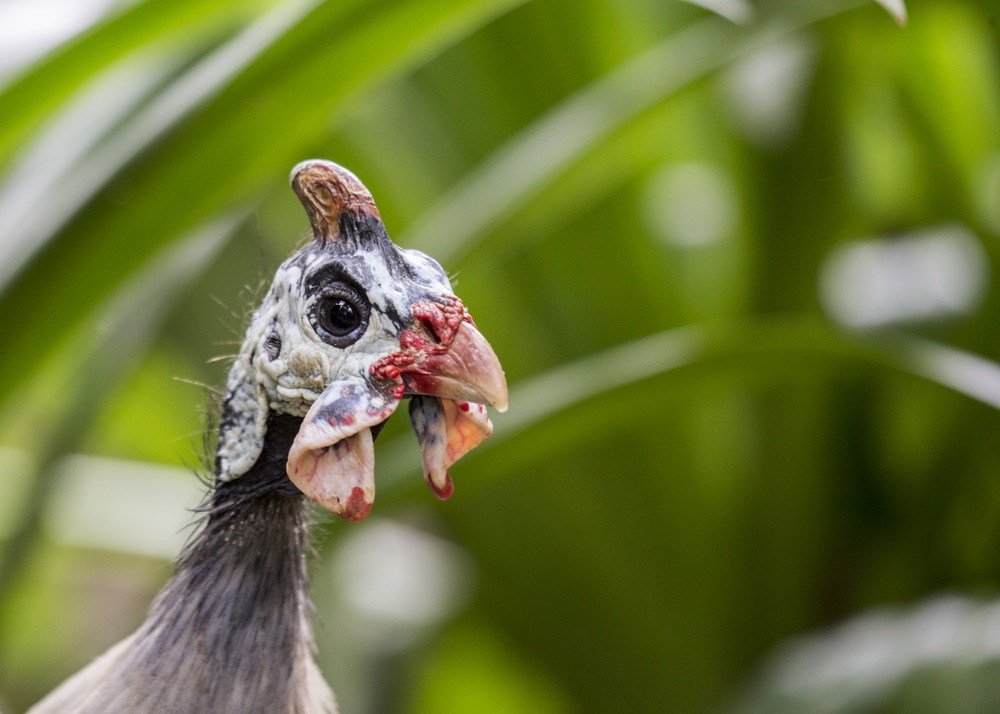
Highly social creatures, guineas get along best with members of their own kind. They move in groups – if one travels, the others are likely to follow.
If one gets lost, the others will call out to it relentlessly until it finds its way back (or until the rest of the flock finds it).
Be Careful of Aggression with Other Species
You can raise guineas with birds of other species, like chickens or ducks, but you need to be very careful in doing so – especially in regards to males.
The reason for this has to do with their tendencies towards aggression.
Think of the most aggressive rooster you have ever had. Then, multiply this by ten!
In fact, guineas can be so aggressive that they can run off the toughest rooster in your flock! Male guineas are notoriously territorial and will bully others in the flock.
Pecking Orders
The pecking order among guineas is quite brutal. They won’t limit their domineering behavior to members of their own kind but will bully indiscriminately.
If you are able to raise your guineas as keets with a group of young chicks at the same time, you may have better results.
Challenges with Confinement
Raising guinea fowl presents several other challenges, too. These birds are mostly wild, so they don’t usually do well in confinement.
You may notice that they have a tendency to roost in trees or other high areas at dusk instead of inside the coop.
You can eventually train your guinea fowl to come inside the coop at night by enticing them with some fresh water and a mixture of cracked grain and feed.
They aren’t fond of entering dark places, so hanging a light bulb in the coop can help encourage them to come inside, too. You can always turn this off once night falls.
Space Requirements
Remember that the same rules regarding chickens and personal space apply to guineas, too.
Make sure you give them at least two to three square feet apiece – any less than that, and you’ll notice that they become stressed and gaunt-looking.
If you are able to provide them additional space for free-ranging, that’s all the better, but you will still need at least two square feet of space inside the coop per bird.
One of the things that people love the most about guinea fowl is that they mate for life when living in the wild.
These birds are monogamous, and provided with the proper male-female ratios, will stick to one partner for their entire lives.
Try to maintain a ratio of one male to five females for best results.
Are Guinea Fowl Good for Eggs?
As seasonal layers, guinea fowl can lay eggs all throughout the year, laying about one egg per day between March or April and September or October.
This is dependent on your climate and location, of course, but usually, one guinea hen will lay about 100 eggs each season. These eggs are smaller than those of chickens and tend to be pale brown in color. They often have speckles and are very hard-shelled.
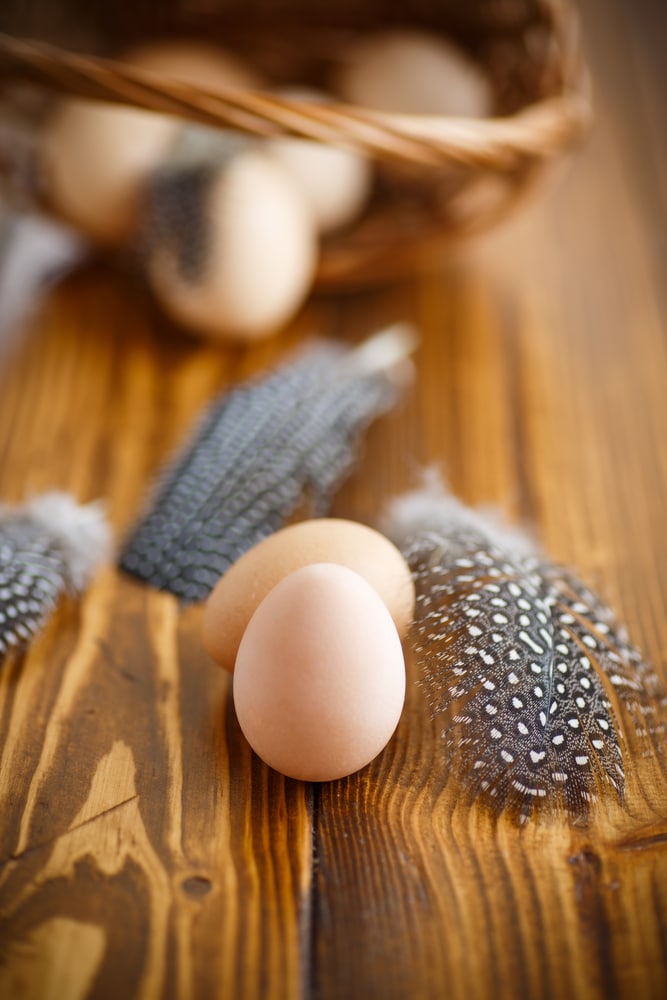
One of the richest kinds of eggs you can eat, they are often compared to eggs of other types of poultry, like ducks.
Guinea hens are communal layers, with all hens laying in one nest until there are dozens of eggs. They also tend to brood communally, which is why they pile eggs – they will take turns sitting on the nest once it’s time to brood.
Unlike chickens, guineas are not fussy about where they lay an egg.
They will do it wherever the mood strikes them, but generally, they will choose a location that is somewhat protected from predators. Males stand watch for the hens, keeping an eye out for danger during the hazardous daylight hours.
You might find guinea eggs just about anywhere on your property, including in the forest, in the long grass or hay, or even under structures.
To prevent them from “hiding” eggs on you, you might want to keep them locked up until noontime.
They usually lay in the morning, so if you can keep your birds contained until then, you’ll have a much easier time finding and collecting the eggs.
If you want to hatch your own guinea eggs, don’t worry – this can easily be done. You will need to keep them in the incubator for anywhere between 26 and 28 days.
If you are relying on a broody guinea hen to do the work for you, know that after hatching, the guinea keets will follow their mother back to the flock.
It is very common for guinea keets to die in the wild. They often suffer from cold, wet conditions and are also subject to predation when they are under the age of four weeks old.
However, if they do make it past the four-week mark, there’s a good chance that your birds will become healthy adults!
Are Guinea Fowl Good for Meat?
Many people choose to raise guinea fowl for pest control or as pseudo-guardian animals, but they can also be raised for meat.
In fact, guinea fowl are known for being lean, flavorful, and quite tender. White like chicken, guinea meat has a unique taste like pheasant yet without the intense gamey flavor.
With less fat and fewer calories than chicken, it has a heavier breast and smaller bones, too. Therefore, even though a guinea might look to be the same size or just a tad larger than a broiler chicken, you will yield much more meat.
Size and Meat Production
The average guinea dresses out to 75% of its live weight, which is more than 70% you might get out of a chicken.
Mature hens will weigh about three pounds and cocks will be roughly four.
You can determine whether a guinea is prime for eating by feeling the flexibility of its breastbone.
The younger and more tender it is, the more flexible its breastbone will be, too.
The best guinea meat will be from 12-week old birds that weigh about two pounds. This is when you will be at the optimal levels of feed conversion as well as when the meat will be the most tender.
When it comes to dressing and preparing the bird, you will follow the exact same steps as you would if you were butchering and cooking a chicken.
Health Issues of Guinea Fowl
As you know, guinea fowl aren’t easily domesticated!
As a result, it has been difficult – if not impossible – for humans to “improve” upon the species in any way through selective breeding. On the flip size, though, guinea fowl have very few health issues.
A hardy bird in most environments, the guinea fowl does best in warmer weather. Native to Africa, it prefers a warm, dry, and draft-free environment.
Guineas have a tendency to struggle during extreme cold, snowy, or wet conditions.
Try not to catch these birds by the legs. They are not like chickens that can be handled in this way – they have a tendency to turn around quickly and can easily break or dislocate their legs.
Raising Guinea Keets
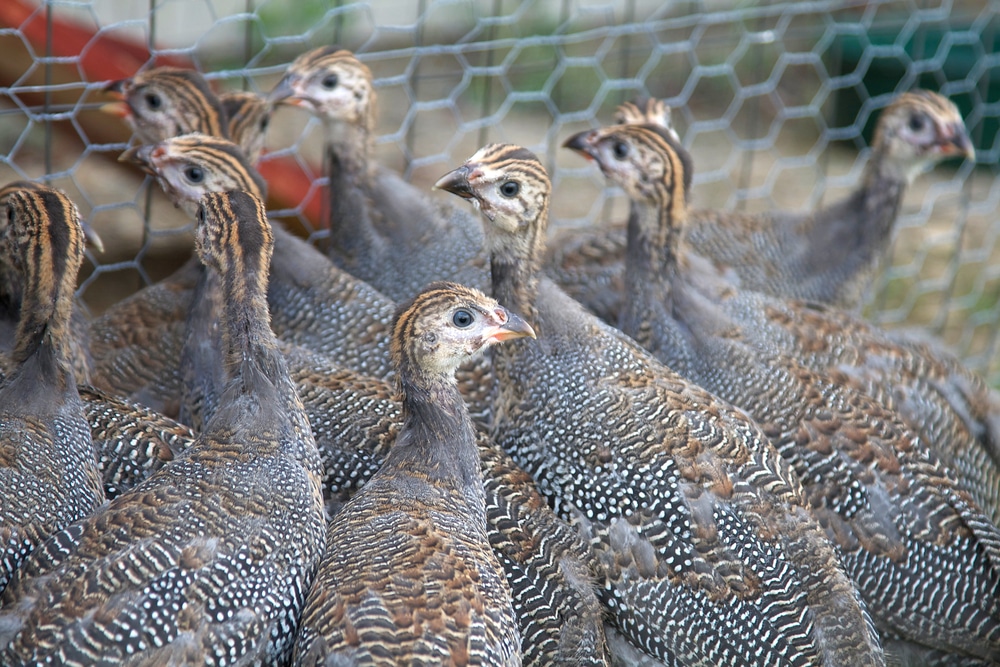
Raising guinea fowl starts with raising guinea keets – or young guinea fowl.
These birds need high-protein feed as youngsters, just as chicks do. Until they are five weeks old, you should feed them a high-protein ration of about 24-28%.
Once they reach five weeks old, you can reduce the protein to 18-20%, and once they are eight weeks old, you can drop even further to 16%.
Whatever you do, try not to feed pelleted feed.
They will have a harder time digesting this. You should also avoid feeding medicated feed, as it’s toxic to guinea fowl.
While you will want to start your guinea keets in a brooder, just as you would with baby chicks, you can later move them out to pasture.
If you allow your guineas to free-range, they will spend most of their days foraging, working as a team to devour anything that comes into their paths.
Guineas also like to scratch, just like chickens. While it’s less likely to dig up your lawn than a chicken is, it’s important to pay attention to where you house them so that they don’t scratch and dig up areas you don’t want them to.
Benefits of Raising Guinea Fowl
Here are a few positives of raising Guinea Fowl:
Guineas are low-maintenance poultry
Although they aren’t as friendly as other types of birds, they require very little care, since they can mostly fend for themselves.
They are almost entirely disease-free and can adapt to all but the most severe climates.
You don’t need much of a shelter
In fact, shelter is really only necessary to guard your flock of guineas against threats from predators like foxes, dogs, coyotes, and owls.
A simple three-sided shelter is all you need, as long as it has a draft-free perch area and a wire front. Ideally, about seven inches of roosting space per bird is desired.
Feeding guinea fowl is easy
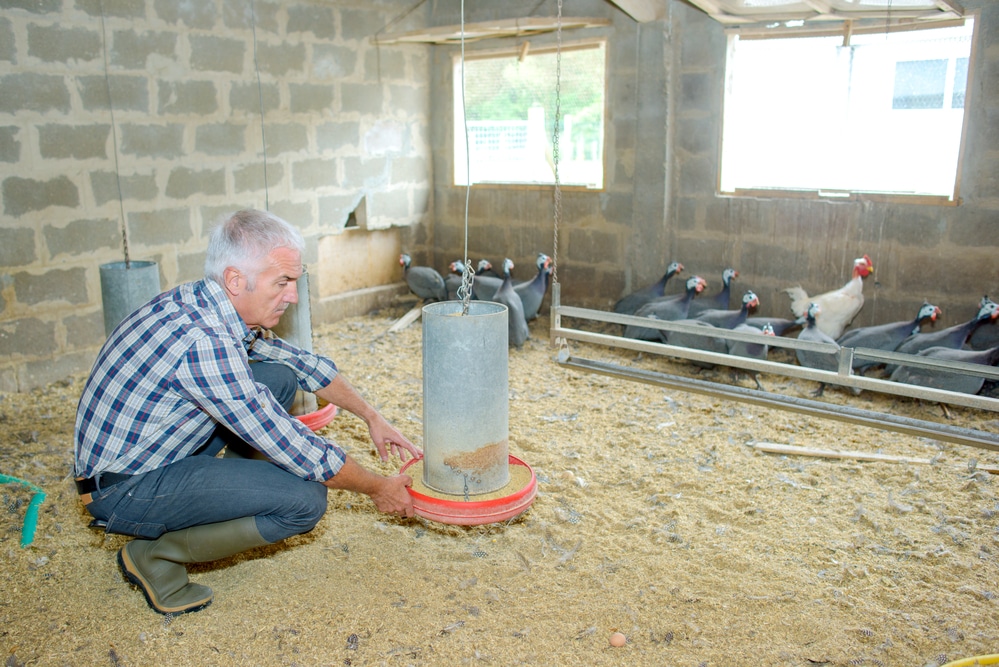
If you allow your flock to free-range, you will find that most of their dietary needs are met.
Otherwise, you might just need to provide them with water and a few handfuls of grain to get them inside at night.
Hatching keets is usually a simple process
If you want to hatch your own guinea keets, you will have good success.
Egg fertility is rarely an issue. As long as you maintain the appropriate cock-to-hen ratio, you will enjoy nearly 100% fertility!
Guinea fowl form close bonds with each other. Hens are protective of their babies and will lead their offspring wherever they need to go.
Males are protective, too. If a mated hen and cock are divided during feeding, the two will panic until they reunite with each other.
Guineas provide great pest control
Many people enjoy raising guineas because of the value they add in being able to remove pests like ticks, snakes, and other creatures from the backyard.
They are excellent at pest control, and can also help guard your flock with their piercing cries. You won’t have any visitors show up unexpected – that’s for sure!
Add in the fact that guineas can be raised for eggs and meat alike, and you have an almost perfect backyard poultry breed!
Challenges of Raising Guinea Fowl
One of the biggest challenges of raising guinea fowl that many keepers have to address is that managing them is significantly different than managing chickens, ducks, or other types of poultry.
For example, it can be incredibly tough to catch a guinea hen.
It’s easiest to catch a guinea after dark, but you need to be quick. You can’t catch one of these birds by their legs, either – if you do, the bird runs the risk of breaking a bone.
Another unique issue with raising guinea keets has to do with their inquisitive nature.
These birds aren’t afraid of much, and will spend a great deal of time getting into trouble on your farm! If you keep bees, make sure you protect the hives.
Guineas will sit outside or on top of them and eat bees as they emerge.
Keep in mind that guineas can mate with chickens!
This is not necessarily problematic – the birds look quite odd but are otherwise healthy – but does lead to sterile offspring.
Finally, guineas can be a challenge to raise in that they are not quiet birds.
If you have nearby neighbors or simply don’t want to listen to their constant chattering day and night, these might not be the birds for you.
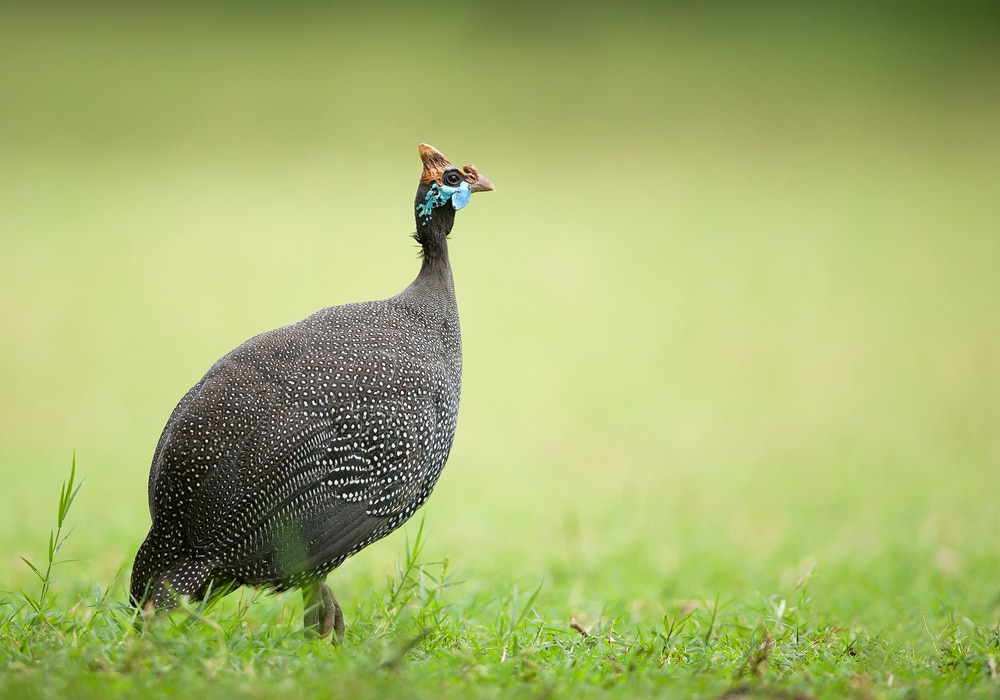
Are These Birds Right for You?
Although guinea fowl have been raised in captivity for thousands of years, they have yet to become truly domesticated species.
Not a cuddly or supper friendly bird, the guinea fowl does not like to be picked up and is not likely to become your next new pet!
However, they offer a great deal of entertainment.
Not only are they fun to watch as they patrol your backyard, but they can also get rid of pests like snakes, rodents, ticks, insects.
They can let you know when an intruder is present and can even keep certain predators away from your flock.
While the guinea fowl is definitely an acquired taste, there are plenty of people who absolutely love raising them. You might be one of them!
A long-lived species of poultry, this bird can live up to 15 years when raised correctly. Consider adding a few to your backyard flock!
